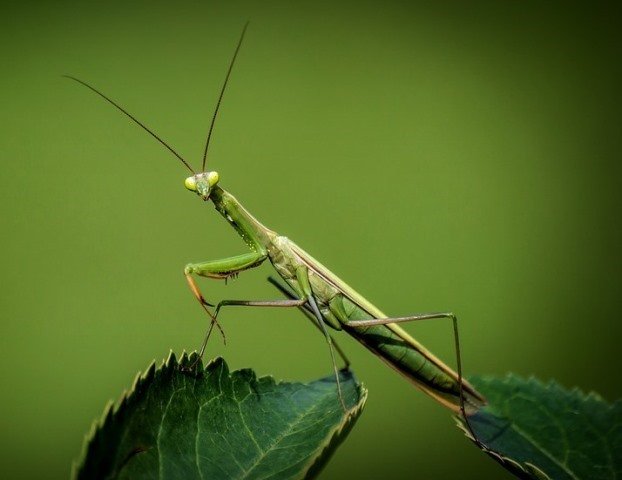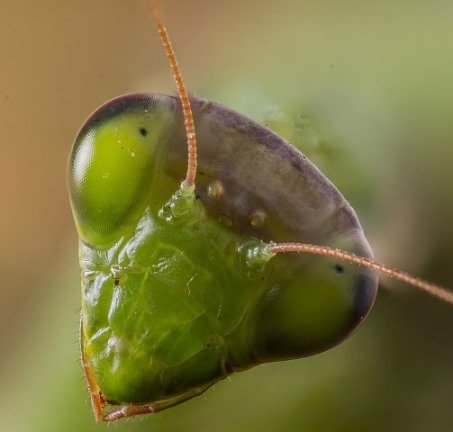The Vision of Praying Mantis Can Inspire Simpler Vision-Processing For Robots
Have you ever wondered why we can’t actually visualize two different things at the same time, even when we have two different eyes? Lolz….well, welcome to the club.

I have also wondered how people who via some accident or birth deformation, have lost an eye and have just the one functioning eye, can see exactly what people with two pair of eyes see and sometimes even better.
So, it begs the question why can’t people with two eyes, see two different images with the two eyes at a time?
Well, the answer to that is explained easily via biology, in the sense that our brain gets to run the show. Whatever our eyes actually visualize, the brain in cognizance of the role of our eyes goes on to interpret the lighting and image captured by our eyes or what we see.
And for humans, using both our eyes represents our 3D or stereo vision, and this combo between the brain and our eyes give us a perfect visual representation. But then, how do our vision work?
We’ve got two eyes, how do we see with both?
From biology, we know our brain interprets images we visualize through our eyes, to gives us meaning with regards to understanding our environment.
But then, the human eyes are quite unique in the sense that we have stereo vision or 3D vision which helps us to interpret the distances between the things we see.Our two eyes see a slightly different view or perspective of our environment. It is our brain that then gets to merge these two perspectives into a single image, with a clear definition, and at the same time uses the differences obtained from the two perspectives to work out the distance of things that are far away.
What other animals possess stereo vision?
We aren’t the only beings with stereo vision. Animals such as toads, owls, cats, monkeys, horses also possess stereo vision. However, in the insect family, only the “praying mantis” is known to have stereo vision.
What are scientists learning from insect vision?
Currently, the fascination with the vision of insects such as bees, bugs, and the crawlers such as leeches, earthworms, etc., have been generating interest from various organism behavioural ecologists.
But the most recent study of bug-eye has been undertaken by a team of scientists at the Newcastle University’s Institute of Neuroscience.The investigation was funded by the Leverhume Trust, and the scientists have been at work to determine whether the only insect with 3D or stereo vision – the praying mantis – can actually see things the way humans do.
As part of their investigation, the scientists developed a special 3D insect glasses which were glued unto a mantis with beeswax (an insect with cool glasses – isn’t that amazing?). With the glasses worn by the insects, the scientists could show them a movie (like a 3D cinema) of a tasty prey, which is seemingly hovering in the mantis’ front. The illusion appears to be so real that the mantis insect tries to catch the prey.
With the 3D cinema-like glasses which the scientists wore the mantis, they further showed the insects, not just movies of tasty preys within reach, but also showed the mantis, dot-patterns which are used to study human 3D vision. The procedure helped the scientists to compare the 3D vision of humans and the insect for the first time.
How do the mantises then visualize things?
For us humans, our eyes are very good at viewing 3D still images. This is possible by matching up the details of the image seen with each of the eye. Mantises on the other hand, don’t have their 3D view like humans; they only attack moving prey, which means their 3D perspective does not necessarily need to work on still images.

The researchers at the Newcastle University’s Institute of Neuroscience discovered through the study, that mantises do not care about the details of an image or picture, instead they just watch out for where the picture itself is changing.
The study revealed that the mantis’ stereo vision is quite robust, in the sense that, even if they made the two eyes’ images completely different, the mantises can still watch out and pick up places where the images they see are changing. This is what humans can’t actually do, but mantises are able to do.
One of the researchers Dr Vivek Nityananda, a behavioural psychologist at the Newcastle University, stated that:
"This is a completely new form of 3D vision as it is based on change over time instead of static images. In mantises it is probably designed to answer the question 'is there prey at the right distance for me to catch?'"
How the discovery can be of benefit in robotics
It is reported that many of the robots we are accustomed to use stereo visions to aid their navigation, however, the mechanism for the robots is based on human’s complex stereo vision. But when we consider that insects are very tiny, it then implies that their stereo or 3D vision would not require too much computer processing.
It then means that the study and future adoption of the insect’s stereo vision can aid the creation of useful application in autonomous robots that use low-power.
In a wider research into the praying mantis striking movement, an electronic mantis arm which mimics the insect’s exact striking action is being developed via a research by a student of engineering at the Newcastle University.
Conclusion
The study of the scientists at the Newcastle University’s Institute of Neuroscience, UK, revealed that the miniature glasses attached to the praying mantis insects showcased a new form of 3D vision, which can go a long way to aid simpler processing of vision and visual representation for robots.
The discovery was made after research investigation of how the mantis sees and views things showed that the praying mantis, considered as the only insect with a 3D or stereo vision, possesses a vision that is very different from all other biological 3D vision which have been previously known.
Image Source: Pixabay - [1], [2], [3], [4]
Reference:
Thank you for your time and for reading my post.
If you found this post interesting, then kindly UPVOTE, RESTEEM and FOLLOW @rickie, for more quality posts.
You Can Check Out My Other Posts Below:
- Undiscovered and Unknown Viruses Can Now Be Hunted To End Global Viral Pandemic
- A Device For Administering Drug Directly To The Brain Is To Become Neurological Game-Changer
- Science Says Casual Sex is Freaking Healthy, So Do It
- Is it possible to die from laughter?
- Scientists Discover Antibacterial Properties Of Dragonfly Wings
- Meet The Fish That Sparks Fear and Attacks The Human Penis and Urethra



Well written and very interesting indeed
Thanks for reading @chelsea88
Congratulations! This post has been upvoted from the communal account, @minnowsupport, by Rickie from the Minnow Support Project. It's a witness project run by aggroed, ausbitbank, teamsteem, theprophet0, someguy123, neoxian, followbtcnews, and netuoso. The goal is to help Steemit grow by supporting Minnows. Please find us at the Peace, Abundance, and Liberty Network (PALnet) Discord Channel. It's a completely public and open space to all members of the Steemit community who voluntarily choose to be there.
If you would like to delegate to the Minnow Support Project you can do so by clicking on the following links: 50SP, 100SP, 250SP, 500SP, 1000SP, 5000SP.
Be sure to leave at least 50SP undelegated on your account.